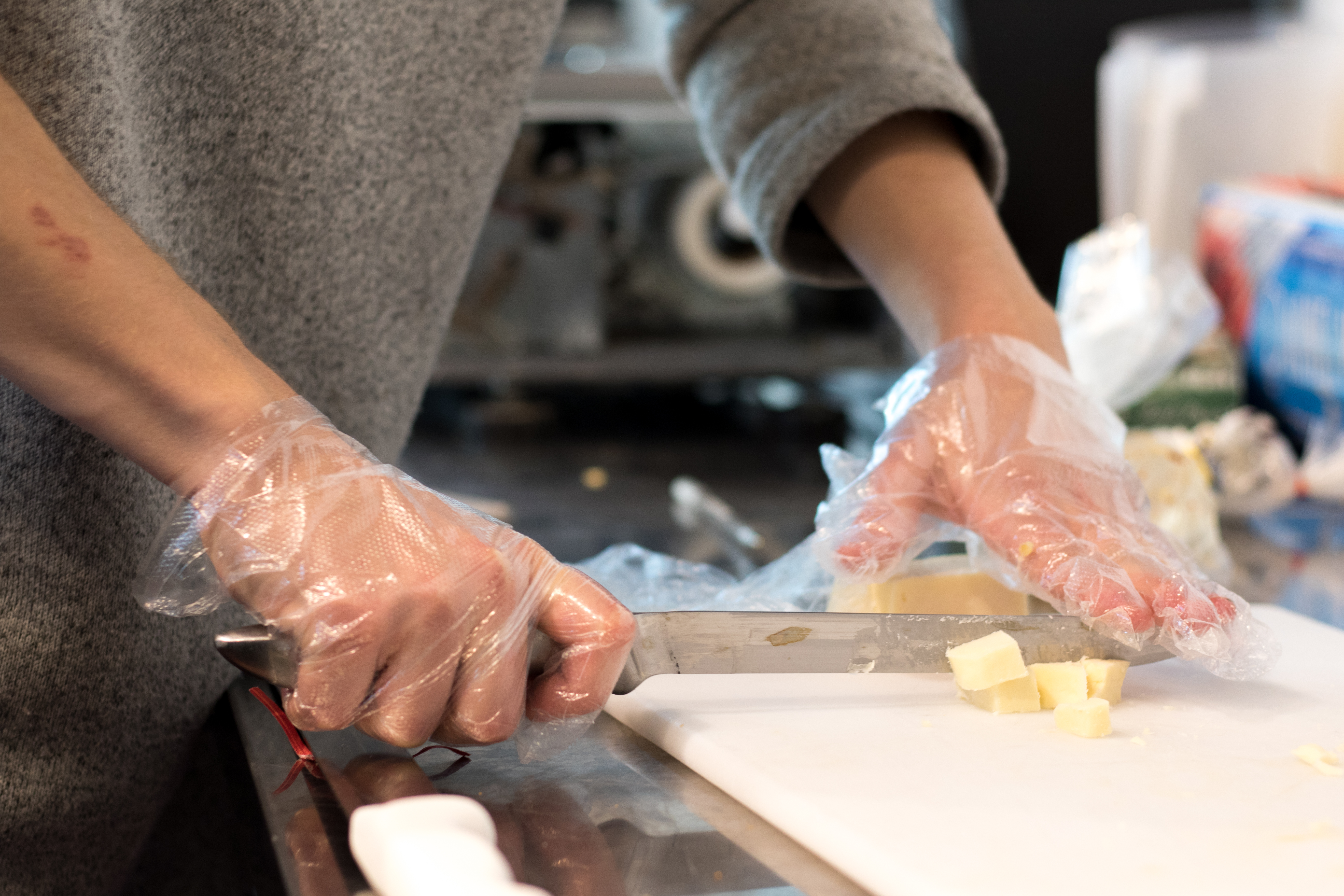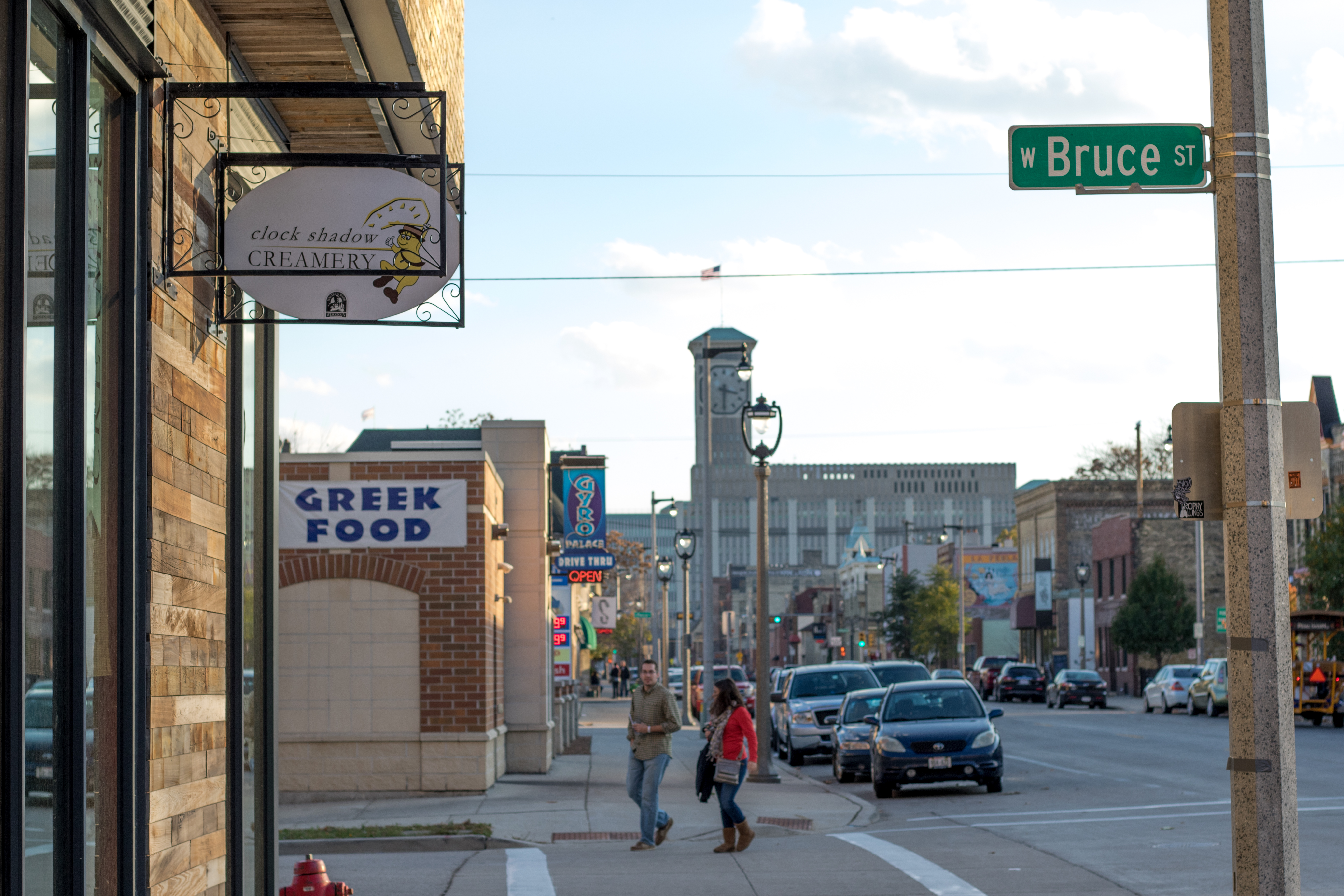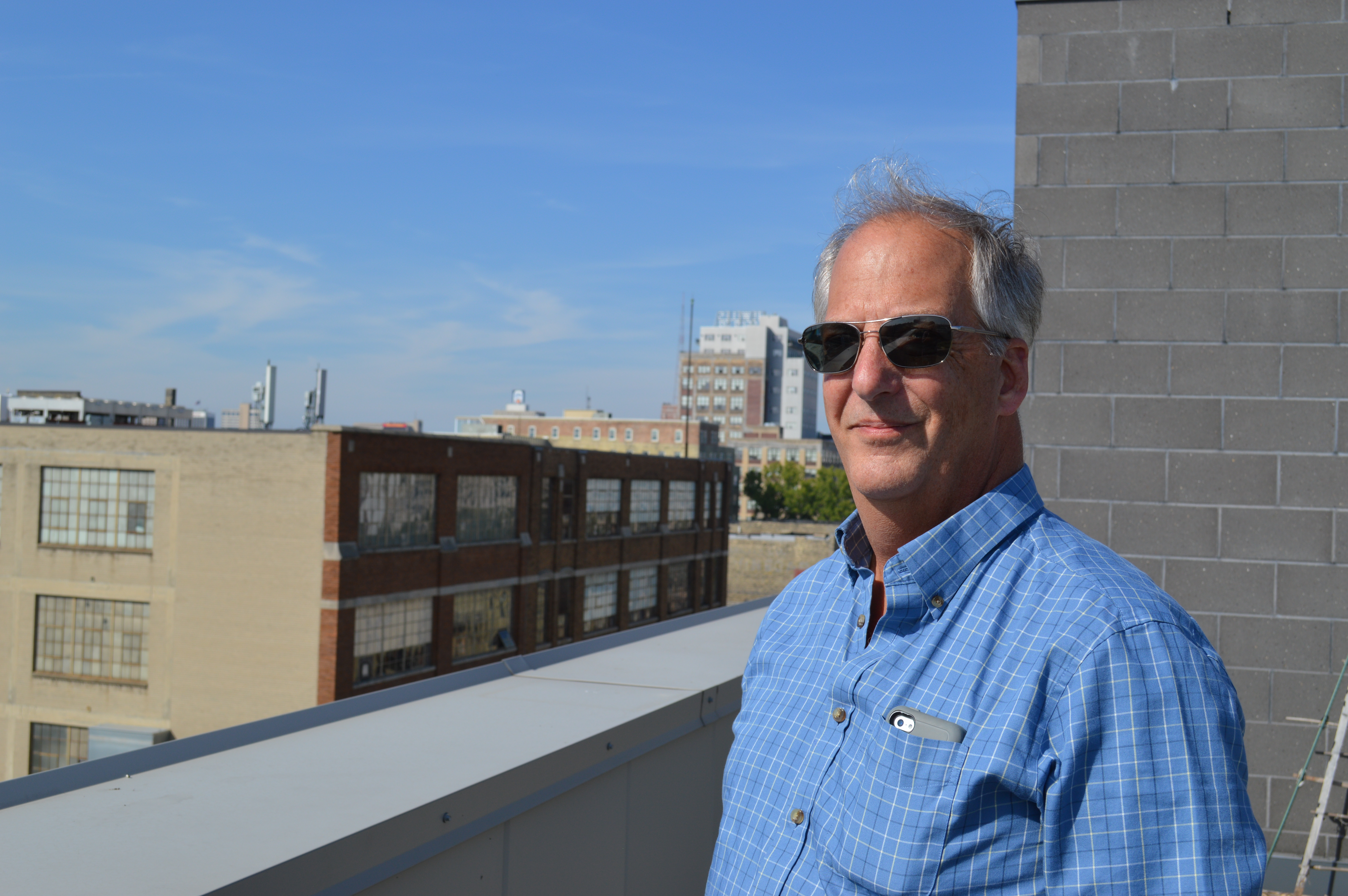Master cheesemaker Bob Wills looks out across Milwaukee’s South Side from the roof of the Clock Shadow Building. His eyes dance between the steeples and spires that dot the city’s skyline. To the south, he sees the round dome of the Basilica of St. Josaphat and the cross that tops St. Michael’s Ukrainian Church. To the east lies the Hmong Alliance Church. These buildings are numerous and diverse, each of them built for the community they represent and serve.
“The variation is what I really love about this city,” he says.
Wills, founder of the Clock Shadow Creamery, feels at home with the diversity of Milwaukee. Located at the intersection of Second and West Bruce streets, the creamery is just a mile north of Wills’ childhood home on Oklahoma Avenue. While he is a Wisconsin native and a master cheesemaker, he is hardly the “Wisconsin stereotype” he proclaims himself to be. In everything he does, he tries to be an activist.
The Clock Shadow Creamery, an urban cheese factory that is both socially and environmentally conscious, is one of the first of its kind. Cheese is a longtime feature of rural Wisconsin, but in April 2012, Wills brought the state’s best known product to a new environment. Since the Clock Shadow Creamery opened, he and the creamery have played a part in the growth and change in Milwaukee’s Walker’s Point neighborhood.
The sound of construction is faint from the scenic rooftop garden where Wills sits, but walk a block north and the smell of tar becomes overwhelming. The roar of Bobcats and bulldozers is familiar to anyone who spends time in Walker’s Point, a neighborhood on the south side of the city. It is a community in transition.
For years, local developer and community activist Juli Kaufmann lived across the street from a barren, polluted field in Walker’s Point. Where many would see yet another blemish in a run-down neighborhood, Kaufmann saw potential.
“I looked at it as an opportunity to improve my own community,” Kaufmann says.
Kaufmann turned that empty brownfield site into the productive force that is now the Clock Shadow Building. She is the president and founder of Fix Development, and she conceived, created and executed the construction of the Clock Shadow Building.
She and Wills share a passion for social and environmental activism. Cedar Grove Cheese, his rural cheese factory in Plain, Wisconsin, in the south central part of the state, features a water treatment facility that uses microbes and plants to clean water, one of the major waste products to come from cheese factories. So when Kaufmann suggested the idea of an urban cheese factory in 2010, the notion of opening a business mere blocks from where Wills grew up piqued his interest.
“Even though I haven’t lived here in a long time, it’s still my hometown,” Wills says. “It’s motivated me to bring that knowledge back.”
That knowledge now sits at the corner of Second and West Bruce streets in the Clock Shadow Building, where the creamery is housed as the first-floor tenant.
Among the run-down, abandoned buildings once used for manufacturing on Second Street, the modern Clock Shadow Building looks like something from a distant future. Daylight streams through large, open windows. The wood siding, reclaimed from pickle barrels, creates a dichotomy between the chic and the traditional that is accentuated within the urban cheese factory’s glass doors. Step inside the creamery, and customers are greeted with the gentle scent of dairy. Patrons are only reminded they’re in the heart of Wisconsin’s largest city if they look out the window.
A unique and welcoming site in downtown Milwaukee, the Clock Shadow Creamery is a cheese store unlike any other. Eric Schuetz, marketing manager of the creamery, says it goes beyond local, striving to be “neighborhood cheese.”
Wills stresses community involvement in every aspect of the cheese-making process.
“Our goal was to connect with the real community and to target both our products and our job opportunities at a neighborhood that really needed assistance,” Wills says.

The Clock Shadow Creamery employs locally for a variety of positions, from retail to production. Photo by Thomas Yonash.
Due to the perishable nature of dairy, many creameries use local dairy and distribute locally, and Clock Shadow Creamery is no exception. Clock Shadow Creamery distributes its products to the Milwaukee, Madison and Chicago areas, and the dairy comes from farms on the urban fringe of Milwaukee. Almost everything the creamery sells was grown or made in central Wisconsin. Besides cheese, the creamery is stocked with items like jams, pickled mushrooms and popcorn labeled “local,” “grown in Wisconsin” and “made in Madison.”
The creamery has taken a step beyond just cheese, making itself integral to the community by reflecting its diversity. The creamery supplies many of the restaurants in Walker’s Point with fresh cheese and encourages local chefs to experiment with new cheeses and recipes.
Many of the cheeses the creamery produces come as responses to requests from residents of the neighborhood. The quark, a European cheese that is extremely popular at Clock Shadow, came at the behest of local patrons, whose European ancestors often talked about the creamy, semisweet cheese. The coalho and menonita are popular among the Hispanic residents who make up nearly 70 percent of the neighborhood.
More than catering to the tastes of the community, Schuetz says the creamery offers job opportunities to everyone in the neighborhood and has employed people from a variety of different ethnicities and backgrounds.
“We have the full range,” Wills says about the local employment opportunities, “from the production jobs where people come in and get trained to become cheese makers, up through retail and truck drivers.”
Moving from running a business in a rural environment to what Kaufmann calls a “transitional neighborhood” is not without its challenges. Wills says his cheese factory in Plain and Clock Shadow Creamery are “like night and day.”
“This is a tougher business than I expected it to be,” Wills admitted.
Despite its base of customers in Walker’s Point, the Clock Shadow Creamery has struggled to find the market it had hoped for as the cheese store closest to more than a million people. There are people who live within a mile of the Clock Shadow Creamery that have no idea they exist, and to him that is fascinating to consider.
“At three years after being here, we still have an awful lot of people coming in and go, ‘I didn’t know you guys were here,’” Wills says. “In Plain, not only do we know everyone, but everyone knows us.”
The creamery has received a great deal of free publicity from radio, magazine and television coverage. Wills says the stations often come to the cheesemakers at Clock Shadow for their advice and expertise.
“It feels from our perspective we’re constantly being visible,” Wills says.
Crime, parking violations and permit regulations are among the other issues Wills and the staff of the urban creamery have faced in their time on Second and West Bruce, all things Wills never had to consider at Cedar Grove Cheese.
“It requires us to have a level of carefulness that didn’t come naturally,” Wills says.
Walker’s Point is a bar district, and as the commercial scene booms, people from outside Walker’s Point with spending money come for the night life. These visitors make easy targets, and Kaufmann says crime increased since the Clock Shadow Building opened. There is a one in 14 chance of becoming a victim of any crime in Walker’s Point, nearly 2½ times higher than the national average. Kaufmann tells stories of drug dealing and gunfights.

The employees at Clock Shadow Creamery go beyond local, striving to be “neighborhood cheese.” Photo by Thomas Yonash.
“People aren’t going to want to live there if it’s a dangerous place,” Kaufmann says.
Local residents have fears of their own. To the long-time locals, the neighborhood is known as Walker’s Point, but real estate agencies know it by a different name. The recent revitalization of the community attracted the attention of outside real estate companies, who address the 53204 ZIP code area as the “Fifth Ward.”
The increased attention in real estate led to concerns of gentrification in a community that has spent the last several years in economic redevelopment led by artisanal, community-minded businesses like the Clock Shadow Creamery. The Walker’s Point Association formed amid apprehension of long-time locals and small businesses being displaced by rising property values. Anne Nordholm, director of community relations for the Walker’s Point Association, says the association was created to balance business and residential interests in the neighborhood.
She stressed the importance of neighborhoods that mixed residential and commercial, a sentiment echoed by Kaufmann.
“The way a neighborhood remains successful, in my view, is having a diversity of uses,” Kaufmann says.
The Clock Shadow Creamery is the type of local, artisanal business that is breathing new life into the Walker’s Point neighborhood. Last year, the Walker’s Point redevelopment won the Milwaukee Business Journal’s Project of the Year award. In a neighborhood that has struggled with crime, unemployment and poverty, Wills says the economic climate has improved.
“We’re on the cutting edge of a trend to encourage people to come to this area,” Wills says.
Wills understands that there are challenges inherent to running a business in downtown Milwaukee, but that has not curbed his bright outlook.
“I remind myself that we chose this,” he says, looking out across the neighborhood. From the roof of the Clock Shadow Building, it’s hard not to be optimistic about the future of Walker’s Point. Just across the street, people crowd into Milwaukee Brewing Company, a company with an environmental conscience similar to Wills’ and Kaufmann’s. The nearby Anodyne Coffee offers Ethiopian and Honduran brews and a variety of craft beers for customers to drink as a variety of local bands play on a large hardwood stage built into the coffeehouse. According to Nordholm, developers recently broke ground on a new Cermak grocery store, the neighborhood’s first.
Down the road, the restaurant, Braise, sources nearly every one of its ingredients locally. Dave Swenson, the chef and owner of the community supported restaurant, uses Clock Shadow Creamery’s cheese to fuel his culinary imagination. Braise was originally intended as the tenant of the Clock Shadow Building’s first floor where the creamery is now, and Wills says Swenson has been supportive of the creamery from its conception in 2010.
Outside the door of Clock Shadow Creamery hangs a sign with the creamery’s logo. A cheese curd wearing a hat and round spectacles hangs from a clock, giving visitors a friendly thumbs-up. His employees hate it, but Wills chose the logo for its whimsy. As the businesses in the neighborhood compete to be the most cool, urban and hip, Wills strives to be fun and welcoming.
“It’s a neighborhood they might not have gone into two years ago,” Wills says. But he is confident that change is in the air for Walker’s Point, mixed with the scent of fresh curd.


